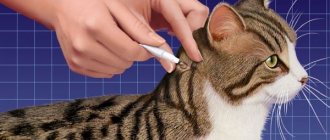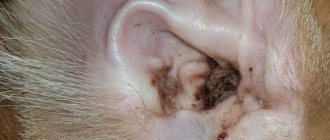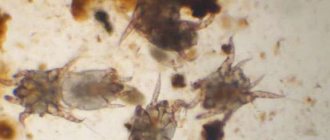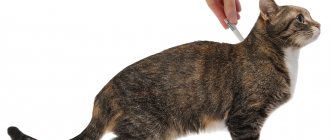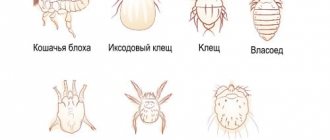Diagnosis and treatment
In a number of external manifestations, demodicosis can be similar to skin dermatitis and ringworm.
Therefore, in addition to an external examination, the doctor will definitely prescribe laboratory diagnostics for an accurate diagnosis and prescribe subsequent treatment. To do this, using a scalpel, a deep scraping is taken from the skin in several places and examined under a microscope. When confirming the diagnosis, specialists identify a certain number of tick individuals at different stages of their development (egg, larva, nymph, adult). When a diagnosis is refuted, that is, a safe carriage, specialists detect only adult individuals or their complete absence. Demodicosis can be treated quite well if the treatment regimen is correctly selected by the doctor and timely contact with him. Advanced forms will have to be treated for a long time: from several weeks to a year. It is advisable not to let this happen, nor to self-medicate using traditional methods, but it is better to immediately consult a doctor without wasting precious time. Treatment will be effective only with a combined approach of a set of measures in the fight against ticks and the targeted restoration of the health and immunity of the animal.
Usually the doctor prescribes the following set of medications:
- Antiparasitic injections of the ivermectin series under the skin, observing the exact dosage: Amirtrazin, Ivermectin, Baymecom, Eprimek, Otodectin, Ivomek, Novomek, Aaversect, Dectomax, Cydectin, etc.
- External solutions of drugs Stomazan, Butox, etc.
- Immunoparasite. Very effective. The drug helps to increase the body's resistance to parasites, activating its protective functions and protects against their re-introduction. In addition to this drug, Gamavit, Gala-vet, Immunol, Maxidin, etc. are also effective.
- To relieve skin inflammation, anti-inflammatory and special topical agents are prescribed in the form of ointments, gels (sulfur ointment, Pikhtoin, sea buckthorn oil, Demos liniment, Amidel gel, Ivermect gel, Aversectin ointment, Saphroderm ointment, Cythioate ointment, etc.). A greater effect is achieved after bathing and cleansing the skin of crusts.
- External special sprays of Acaromectin, Ivermectin, Cydem, Pirol, etc. Or irrigate and lubricate the affected areas with a pre-diluted solution of Neostomazan, according to the instructions.
- Use oil preparations Mycodemicil, Tsipam, Ectodex, Amit, etc. to treat bald spots with scabs. You can use simple oils: sea buckthorn, flaxseed, olive. Oils are very effective for this disease. It is necessary that they are absorbed into the skin, and the cat should not be allowed to lick them. She can be wrapped up. Only after the oil has been completely absorbed should external preparations be used as prescribed by the doctor.
- Skin application of Stronghold or Advocate once a month between the shoulder blades. A course of 2-4 months.
- Vitamins, minerals and microelements (Vitam, etc.).
- If a secondary bacterial infection is detected, the course will have to include antibiotics (Ammoxicillin, Kanamycin, Baytril, Betamox, etc.).
- A cat with demodicosis should be bathed using special shampoos “Doctor” with benzoyl peroxide, “Elite” with chlorhexidine in order to clean the surface of the animal’s skin.
- Treat the skin with solutions of hydrogen peroxide or chlorhexidine. This measure will clear it of scabs, ulcers and crusts. Subsequently, gently and thoroughly blot and dry the skin. Thus preparing for the application of the above-described drugs.
In addition to medications, the owner must provide his pet with a complete diet rich in protein, vitamins, and minerals. Improving living conditions also plays an important role: wash and boil all grooming equipment, bedding, comb, plates, toys, litter tray. You can simply disinfect them in disinfectant solutions and then rinse them well. Use an iron with hot steam over the surface of the sofas, frequently carry out wet cleaning with disinfectants, and temporarily remove carpets. If there are other cats in the house, they also need to be diagnosed and treated.
Therapy should be carried out only under the supervision of a physician. Treatment can be considered complete only when the results of two repeated laboratory examinations of scrapings give a negative result.
The owner, among other things, should not forget about preventive measures in the future in order to avoid a relapse. And at the first suspicion, immediately contact the veterinary clinic.
The causative agent of demodicosis in cats is the subcutaneous mite.
There are two types of subcutaneous mites that live on cats and cause demodicosis:
- Demodex cati is long and thin, lives in the hair follicles of the animal. This type of tick is not contagious and cannot be transmitted from cats to other pets or humans;
- Demodex gatoi is short and thick, lives in the stratum corneum of the skin. Contagious, transmitted from cat to cat. It is not dangerous to other pets or humans.
The first species (Demodex cati) is a kind of “orderly”, part of the normal flora of a healthy cat’s body. But under certain conditions: animal illness, stress, decreased immunity, subcutaneous mites multiply excessively - the cat gets sick.
The second species (Demodex gatoi) is an infectious ectoparasite. This subcutaneous mite can be transmitted from one cat to another. Cats of different breeds and at any age suffer from demodicosis.
Note! Both species are so small that they can only be seen under a microscope - no more than 0.5 mm. Microscopic mites feed on dead skin cells, sebaceous gland secretions, and cells from hair follicles.
Routes of infection
Ticks are not viable in the external environment (bedding, carpeting), so infection is possible exclusively through contact “from cat to cat”:
- upon contact with a sick animal;
- kittens become infected from their mother;
- intrauterine infection.
Important! If you have several cats, you need to treat all animals in contact.
Risk group
Theoretically, all cats that have been in contact with sick animals can become infected with subcutaneous mites. But in practice, only a few people get sick. The body of healthy animals with strong immunity can independently cope with ectoparasites.
Most often susceptible to demodicosis:
- offspring of cats with demodicosis;
- animals with weakened immune systems and autoimmune diseases;
- cats in the postoperative period;
- animals in the recovery period after infectious diseases;
- kittens and adult cats with rickets;
- animals exhausted after starvation;
- pets who have suffered severe stress;
- some breeds: Siamese, Burmese, Devon Rex, etc.
Demodicosis in cats
Demodicosis is a parasitic disease that is caused by the subcutaneous scabies mite - Demodex. Demodectic mange affects dogs, cats, and humans. But a cat suffering from demodicosis is not dangerous to humans
There are two types of mites found in cats: Demodex cati and Demodex gatoi.
Demodex mite is microscopic in size. Normally, small numbers of Demodex cati mites live in the hair follicles and sebaceous glands of each cat. They become the cause of disease only when the animal’s immunity is weakened.
Another type of tick, Demodex gatoi, lives on the skin; infection occurs through close contact between a sick and healthy animal, for example, when sniffing a cat. The owner can bring contaminated fur particles into the house on their shoes.
According to statistics, demodicosis is rare in cats. The disease is very contagious to other cats, treatment is long and difficult. Animals rarely recover without treatment.
Demodicosis is more common
- in immunocompromised cats
- after infectious diseases
- having endocrine diseases
- in animals infected with fleas, helminths
- in cats with skin damage
- in case of violation of the conditions of keeping a sick and healthy animal
Symptoms of demodicosis in cats
Lesions in the ears, nose, eyes, mouth, paws.
Manifestations of demodicosis in cats are classified as:
localized form - limited areas of skin lesions: five or less areas;
generalized form - the affected areas merge, forming vast fields; in extreme cases, almost the entire surface of the body can be affected.
If the cause of the disease is a mite of the species Demodex gatoi, which lives on the surface of the skin, the cat may experience severe itching. In contrast, the Demodex cati mite lives in the sebaceous glands or hair follicles and does not initially cause much concern to the animal.
Inflammation begins to develop at the site of tick penetration, and therefore the skin here is swollen and begins to turn red (skin hyperemia develops). At the site of Demodex penetration, small tubercles or pustules (3-5 mm in diameter) are formed, from which, when pressed, various liquids can be released: from blood to pus.
If untreated, the bumps can unite and become crusted, and the inflammation can cover large areas of the body, sometimes several parts of the body, and in extremely severe cases, the entire body. Since the skin is affected, its protective function is greatly reduced, and a secondary infection may occur, which significantly aggravates both the general condition of the cat and the duration of treatment.
Do not forget about itching, as a result of which the cat scratches, injures the skin and can itself spread the mite throughout the body, onto the litter and other places.
Common symptoms include:
general depression of the animal: the cat is inactive, may refuse food;
increased body temperature; it depends on the degree of spread of the inflammatory process;
other signs characteristic of an attached infection;
cachexia (weight loss and emaciation), and in extreme cases, death of animals.
Diagnosis of demodicosis
Diagnostics is laboratory only.
Due to the varied form and nature of skin damage, only a veterinarian can determine the true cause. As a rule, the doctor will suggest approximately the following algorithm:
collecting information about the cat’s life history and illness;
clinical examination of the animal;
microscopic examination of skin scrapings.
It is worth considering that if the presence of Demodex is suspected, a skin scraping is taken before the appearance of the ichor, since the mite can only be detected by taking for analysis the cells of the entire thickness of the skin located above the blood vessels. This is due to the fact that the mite penetrates deeply into the skin, and a superficial scraping will be uninformative.
Demodectic mange in cats - photo
Demodex under a microscope
Treatment of demodicosis in cats
Treatment boils down to eliminating the tick itself. To do this, the specialist will select complex therapy, which may include ointments applied to areas of inflammation, injections of drugs (subcutaneous, intramuscular), bathing in medicated shampoos, or oral administration of drugs (by mouth).
And of course, treatment of associated symptoms, based on the general course of the disease.
In addition, another important area of treatment will be:
strengthening immunity;
normalization of skin function and hormonal status, general condition of the body;
proper nutrition, balanced in proteins and vitamins.
Important to remember:
Only a veterinarian can establish the correct diagnosis and, depending on the course of the disease, select medications.
Treatment should not be interrupted even with seemingly positive results; the disease may return with greater force.
Treatment ends only after two negative scrapings with an interval of one month.
Prevention
Avoid contact between a healthy cat and a cat with demodicosis.
Timely detection of the disease and contact a specialist.
Timely preventive treatment of cats against ectoparasites that live on the animal’s skin.
Treating premises, cages, and places of residence of cats infected or suspected of demodicosis with acaricidal preparations, the action of which is directed against ticks.
It is recommended to destroy bedding, feeders, equipment (rags, brushes, etc.) from a sick animal.
Treatment
Medications should be used at home after consultation with a veterinarian. Self-medication can end not only in the absence of results, moreover, in a worsening of the animal’s health situation. The difficulty is that treatment directly depends on the symptoms, characteristics of the breed and the nature of the disease. It is impossible to find out all these factors on your own without consulting a specialist.
Treatment should continue until tests show the absence of demodex mites on the animal’s skin. At the end of treatment, it is necessary to systematically wash the cats' accessories in hot water and soap.
Methods for treating demodicosis at home:
The use of medicinal ointments; Bathing using special shampoos. The course of treatment with shampoos lasts about 4–6 weeks until all the mites die out; Use of special drugs
Since they are toxic to cats, they should be used with great caution; Typically, treatment does not end with eliminating the symptoms of demodicosis in a cat. After this, it is necessary to improve the general condition of the animal as a result of the disease.
For this purpose, the use of special immuno-strengthening drugs is suitable.
Demodicosis in cats: treatment
Treatment for demodicosis in cats must be under the supervision of a veterinarian. Diagnosis of demodicosis is carried out using laboratory research methods. Scraping is done from the affected areas of the skin. The material on the slide is allowed to dry and then stained. The diagnosis is made when mite eggs are found in the material. If ticks are detected in adults, they speak of carrier status. In this case, there is no danger to the cat.
Demodectic mange in cats can be easily cured. There is a huge selection of drugs for this disease. Cures quickly in the early stages. In advanced forms, treatment will take longer, possibly for a year. Self-treatment is useless here. Comprehensive therapy will be effective, including a number of measures aimed at combating the pest.
Signs and symptoms of the disease
The first signs of subcutaneous mites in cats that owners pay attention to are constant restlessness and itching, which is the main symptom of the disease. Later, other signs of this disease appear:
Later, other signs of this disease appear:
- the animal's fur loses its elasticity,
- dandruff and keratinization appear around the cat's eyes,
- in some areas the hair falls out, exposing areas of skin,
- Hard growths, ulcers and wounds bleeding with ichor are formed.
Symptoms of subcutaneous mites in a cat and the area of their manifestation depend on the form of the disease, which can be localized or generalized. The first affects only certain parts of the skin: ears, neck, paws. The second applies to several zones or the entire body of the animal.
In order to determine which subcutaneous tick a cat has, you need to take the animal to a veterinarian as soon as possible, who will take a scraping from the affected area, conduct a diagnosis and prescribe treatment.
Treatment of demodicosis in cats
Demodicosis in felines is a long-term disease. To get an accurate diagnosis, you need to consult a veterinarian rather than trying dubious home remedies to treat an unidentified disease.
The veterinarian will scrape the affected skin and examine it under a microscope. The presence of demodicosis will be indicated by a large number of mites in the scraping. If necessary, additional studies will be involved, such as a biopsy or trichogram.
Treatment of demodicosis in cats is comprehensive:
- at the first stage, parasites are destroyed using injections of antiparasitic agents;
- use ointments, tinctures, antiseptics for treating the skin externally;
- strengthen the body's immune system with the help of veterinary drugs;
- anti-inflammatory ointments are used to restore the skin, which prevent relapse of the disease;
- use complex mineral and vitamin therapy;
- It is also possible to include a special medicinal shampoo.
Treatment of subcutaneous mites in cats
Treatment of diseases caused by subcutaneous mites should be carried out under the supervision of a specialist, depending on which parasitic pathogen caused the development of the disease. Only a veterinarian can give effective recommendations on how and how to treat your cat for subcutaneous mites.
The doctor will tell you which antihistamine drug is best to use for treating animals, and will help treat the affected areas on the animal’s body with ointments or spray.
Localized form
Treating subcutaneous mites in cats in cases where only part of the body is affected is quite simple. To do this, the cat is bathed with “Doctor” or “Elite” shampoos, and the skin on the affected areas is treated with chlorhexidine or hydrogen peroxide.
After the skin has cleared of scabs, treatment can be continued with drugs such as Tsipam, Perol, Ektodes, Ivermek, Neostomazan, Mycodemocid, Amit.
Simultaneously with the treatment of the affected areas of the body with shampoos and solutions, pets can be given medicinal preparations enriched with vitamins and minerals.
Generalized form
When subcutaneous mites infest the entire surface of an animal’s body, it becomes much more difficult to cure.
To combat such an advanced form of the disease, the issue of injections has to be addressed. Injecting cats at home is risky, so consulting a doctor in this situation is simply necessary.
Depending on the form of the disease, the doctor will prescribe the cat a course of antibiotics and drugs that restore immunity.
If the disease has taken a severe form, then the issue of sterilization/castration of the animal will have to be addressed in order to prevent infection of the offspring.
Traditional methods of treatment
To remove parasites and relieve irritation and itching, the animal is bathed in a solution of string, calendula or chamomile. Lubricate the affected areas with birch tar or use a chlorhexidine solution, remove discharge and scabs from areas with lost hair. To speed up the drying of ulcers and wounds, they are lubricated with kerosene.
Types of disease
To make sure the diagnosis is correct, the veterinarian will take a scraping from the cat. Using a scalpel, he will collect pieces of skin in several places. As a result, if the diagnosis is confirmed and the cat is infected, the study will show a certain number of parasites.
Animal demodicosis can manifest itself in varying degrees of severity. To suspect a problem, it is enough to focus on general signs, and only a doctor can provide more accurate information.
Symptoms also depend on the specific type of demodicosis. There are only 3 known:
- Localized. This is the mildest stage. At this stage, redness of the cat’s skin and peeling in the affected areas are noted. Additionally, pustules appear as the skin loses some of its healing properties. The number of affected areas is small and after 1-2 months demodicosis goes away on its own and does not require treatment.
- Generalized. This is a more severe type of disease. During its course, extensive affected areas are observed. The places where the mite is localized are itchy and cause discomfort to the cat. This species is also characterized by bleeding wounds, pustules, and peeling. First, demodicosis appears on the head and neck, then moves to the limbs and back. The lesions tend to merge together and form one large wound.
- Juvenile. The most dangerous and unpredictable type. Appears in cats with a hereditary predisposition to the disease. It is difficult to treat, occurs with complications, and almost completely destroys the body’s defense system.
Demodectic mange in cats
Demodectic mange can also be:
- Primary. When the disease manifests itself after the first contact with the parasite.
- Secondary. In this case, the disease occurs as a consequence of a skin disease and reduced immunity.
Important!
An accurate diagnosis can only be made after receiving the scraping result. Demodicosis has similar symptoms to skin fungus, eczema, pyoderma, ringworm and streptococcosis.
Possible complications
In the absence of proper treatment, subcutaneous mites in a cat can cause a number of negative consequences:
- development of pathogenic microflora inside the body,
- improper formation of hair follicles,
- chronic necrosis processes on the skin of an animal,
- general intoxication of the cat’s body.
The animal becomes thin, emaciated, and takes on an unkempt, patchy appearance. He is plagued by frequent respiratory and gastrointestinal diseases.
Prevention
Subcutaneous mites cause a number of diseases that require long-term, serious treatment, which causes cats a lot of inconvenience and takes a lot of their energy. It does not lead to the formation of immune defense in the animal and therefore no one can guarantee that the animal will not get sick again. Therefore, the owner needs to take care of disease prevention:
- keep the cat's fur and ears clean,
- organize a balanced diet,
- See your veterinarian more often
- limit his contact with stray animals,
- use anti-flea collars, ointments and sprays.
Prevention of demodicosis in cats
Considering that demodicosis can develop in a cat at any time, you should follow simple rules of prevention. To prevent the disease, it is necessary:
- Balance your diet. Your cat's food should contain enough vitamins, minerals and fats.
- Keep your pet's environment clean. Change the contents of the tray and wash the dishes in a timely manner.
- Carry out periodic deworming.
- Carry out additional fortification once every 6 months.
On a note!
The best option would be to administer the Immunoparasitan vaccine once every 3-4 months. It will provide protection against ectoparasites that carry demodicosis.
Thus, any cat can get demodicosis. Given the danger of the disease, it should be treated at the first signs. It is better not to try to diagnose the disease and choose a medicine yourself, so as not to waste time. Treatment is carried out only by qualified specialists.
Treating subcutaneous mites at home
In order to recognize ear diseases in time, periodic examination is necessary.
You can get rid of subcutaneous mites easily if you start proper treatment in a timely manner. However, you must remember that if the treatment is prescribed incorrectly, the animal may die. It is also worth understanding that a diagnosis of demodicosis can only be made by a veterinary specialist after conducting the necessary analysis.
Treatment regimen
In addition, if the animal is severely weakened, it will need restorative therapy, in addition to the specific treatment of demodicosis. It follows from this that each animal will have its own treatment regimen for demodicosis.
Drugs and medications
Amit is one of the acaricidal drugs for the treatment of ear mites.
There are many such drugs on the market in the form of drops on the withers, for example, which have a complex effect against some other parasites. In order to clarify the range of such drops in a particular city and clarify all questions of interest, it is best to contact a veterinarian, at the same time receiving the necessary prescription and specifying the required frequency of treatments.
We must not forget about individual sensitivity and intolerance to certain drugs; self-medication can lead to unwanted complications and deterioration in the animal’s well-being, and even death.
Secondary bacterial infection
Very often, in connection with skin inflammation, in addition to demodicosis, another problem is layered - a secondary bacterial infection. To combat it (and in mild cases, for prevention), antibiotics are prescribed.
In severe cases of the disease, cats are given a drip.
Exhausted animals may need IVs, vitamins and other supportive medications. Local treatments may be needed to restore normal skin condition. It should be understood that in advanced cases treatment may be ineffective.
Timely treatment
An advanced case of ear mites in a cat.
Therefore, timely initiation of treatment is so important. Treatment of the generalized form of subcutaneous mites can take months, so you also need to be patient
In this case, it is necessary to carry out control skin scrapings to monitor the presence or absence of progress in connection with treatment, as well as its correction.
Demodectic mange: subcutaneous mite in cats
It is important for the owner of absolutely any breed of mustachioed purr to be aware of cat diseases. You need to understand the symptoms in order to take prompt measures to treat your pet.
A cat may have ear mites, scabies mites and subcutaneous mites. In this article we will talk about subcutaneous parasites - demodexes, which cause demodicosis in cats.
Domestic veterinarians are inclined to believe that demodicosis mainly affects dogs. The disease is not as common in cats, but it is quite unpleasant.
The disease is caused by mites Demodex cati and Demodex gatoi.
D. cati mites live in hair follicles. D. gatoi - on the surface of the skin, they are the ones that cause itching in the cat.
How are these two types of ticks different? Firstly, in size: D. cati is longer in shape than D. gatoi. And secondly, if the first tick manifests itself only when the immune system malfunctions, then the second one is transmitted through contact with other cats.
Reasons for the development of demodicosis
- If a cat is bothered by Demodex cati, then its immune system is weakened. For example, a pet is infected with the immunodeficiency virus. In this case, the veterinarian, in addition to determining the type of tick, will look for the root cause of the disease.
- If a cat has Demodex gatoi, most likely she has interacted with other cats (on the street, at a show or in a cattery).
Subcutaneous mites in cats (itching), symptoms
Demodex infection occurs in two forms:
A) Localized (skin is affected in several places - up to five to six lesions);
B) Generalized (skin lesions in six or more areas or several parts of the entire body).
Demodicosis in cats is manifested by the following symptoms.
At the onset of the disease, lesions are visible around the mouth, on the ears, on the skin around the eyes and on the forehead. If the pet owner does not notice in time that the cat is sick, the disease will spread to the neck, back, paws and sides.
Small bumps are noticeable on the skin of a sick cat; if you press on them, pus and ichor are released. The skin becomes swollen and turns red. As the disease progresses, bald spots and peeling skin appear.
Demodicosis in a cat, treatment
and prevention
Visual signs can only suggest a specific disease, but a veterinarian can make an accurate diagnosis. The choice of medication will also depend on the form of demodicosis and the severity of the disease.
The doctor will take a scraping from the pet’s affected skin and may perform a biopsy and trichogram.
How can you help your pet fight demodicosis and maintain strong immunity?
- Make sure your diet is balanced and rich in vitamins and microelements.
- Treat your cat with anti-worm, flea and tick treatment in a timely manner.
- Protect your cat from stress as much as possible - do not leave it alone at home for a long time, try to create comfortable conditions, love and care for your pet.
i. Ya-vet.ru. Demodectic mange in cats: symptoms and treatment.
Disease prevention measures
Strengthening the immune system and preventing infection from fleas and worms will help your pet cope with the disease or not get sick at all.
To achieve this, the cat must be provided with:
- Good food. The animal's diet should consist of healthy foods and be balanced in proteins. You should consult your veterinarian about what vitamins and healthy food supplements should be included in your daily meals.
- No stress. The reasons for anxiety in cats are being alone at home for a long time, various moves, and a sudden change in diet. It is necessary to try to create the most comfortable living conditions for the animal.
- Fighting parasites. Worms and fleas weaken the cat’s body and have a depressing effect on the animal. On the advice of a doctor, it is necessary to carry out antiparasitic prophylaxis. The animal is treated for fleas, and after a week or 10 days it is given anthelmintic drugs.
To make sure the diagnosis is correct, the veterinarian will take a scraping from the cat. Using a scalpel, he will collect pieces of skin in several places. As a result, if the diagnosis is confirmed and the cat is infected, the study will show a certain number of parasites.
Animal demodicosis can manifest itself in varying degrees of severity. To suspect a problem, it is enough to focus on general signs, and only a doctor can provide more accurate information.
Symptoms also depend on the specific type of demodicosis. There are only 3 known:
- Localized. This is the mildest stage. At this stage, redness of the cat’s skin and peeling in the affected areas are noted. Additionally, pustules appear as the skin loses some of its healing properties. The number of affected areas is small and after 1-2 months demodicosis goes away on its own and does not require treatment.
- Generalized. This is a more severe type of disease. During its course, extensive affected areas are observed. The places where the mite is localized are itchy and cause discomfort to the cat. This species is also characterized by bleeding wounds, pustules, and peeling. First, demodicosis appears on the head and neck, then moves to the limbs and back. The lesions tend to merge together and form one large wound.
- Juvenile. The most dangerous and unpredictable type. Appears in cats with a hereditary predisposition to the disease. It is difficult to treat, occurs with complications, and almost completely destroys the body’s defense system.
Demodectic mange in cats
Demodectic mange can also be:
- Primary. When the disease manifests itself after the first contact with the parasite.
- Secondary. In this case, the disease occurs as a consequence of a skin disease and reduced immunity.
Symptoms of demodicosis in cats
Demodicosis can appear in a cat at any age. But the hereditary factor and characteristics of the breed play an important role. This is especially true for representatives of the Siamese and Burmese breeds. In these individuals the disease is much more common. To protect your pet from a not very pleasant disease, you need to exclude its contact with street animals.
Signs of demodicosis in cats:
- loss of hair in the area of the ears, nose, eyebrows, paws;
- increase in areas of baldness over time;
- redness of the skin in inflamed areas;
- the appearance of bleeding on rough, scabby, bald skin;
- the location of the tick is observed as an elevation above the skin;
- the appearance of an ulcer with oozing pus;
- the affected skin acquires a rotten smell;
- the surface itches and causes anxiety to the animal.
Treatment of pathology
It is recommended to treat mild demodicosis in cats using specialized shampoos. The detergent should contain chlorhexidine or benzoyl peroxide. Shampoos “Doctor” and “Elite” have proven themselves well.
During washing, the resulting crusts and growths are removed from the animal’s skin, and peeling areas are cleaned. After bathing your pet, you need to carefully dry it with gentle blotting movements. Additional local treatment can be carried out with a solution of hydrogen peroxide or chlorhexidine.
Then it is necessary to use medicinal preparations in the form of ointments, sprays or gels. Therapy for demodicosis is carried out using the following means:
- Sulfuric ointment;
- Aversectin ointment;
- Amidel (gel);
- Acaromectin;
- Perol;
- Ivermek;
- Tsidem.
Professional preparations for the treatment of demodectic mange may only be used as prescribed by a veterinarian and subject to strict adherence to the manufacturer’s instructions.
Treatment of bleeding wounds, characteristic of severe demodicosis, is carried out by applying oil solutions - Tsipam, Amita, Mikodemacid, Ektodes. With demodicosis, the animal cannot avoid itching, so antihistamines may be recommended for the cat.
In the generalized form of demodicosis, therapy is no different from the mild course of the pathology. Additionally, the cat can be prescribed intramuscular injections of the drugs Cydectin and Dectomax. The animal will need to be taken to the clinic, since their independent use is prohibited.
shutterstock
If a secondary infection occurs and symptoms worsen, medications from the group of antibiotics are prescribed - Amoxin, Amoxicillin, Betamox and others. The maximum therapeutic result can be achieved with intramuscular administration.
The cat must be prescribed vitamin-mineral complexes and immunomodulatory agents.
If a sick animal is undergoing treatment for demodicosis at home, then the following recommendations must be followed:
- carry out thorough disinfection of the cat’s bedding and sleeping place;
- isolate it from other pets, since the tick multiplies quickly and the spread of a parasitic infection cannot be avoided.
You can cure a cat from demodicosis by supplementing classical therapy with folk recipes.
- Camomile tea. For 200 ml of boiling water, take 1 spoon of dry product. The composition must be infused for 2 hours. Skin treatment is carried out once every two days.
- Alcohol infusion of calendula (can be purchased at a pharmacy). Used for spot sanitation: once every three days.
- Kerosene. You can carry out a one-time treatment of the affected areas (areas with thinning hair).
- Soap with birch tar. Used for bathing your pet.
Traditional methods will be effective for mild cases of demodicosis. If the cat's condition worsens, treatment must be supplemented with professional medications.
If the treatment is correctly selected and all recommendations are followed, the first positive results will be noticeable after a few months. The total duration of the course depends on the degree of infection of the cat.
shutterstock
Preventive measures
In order to avoid symptoms and treatment of subcutaneous mites in cats in the future, it is necessary to take care of prevention in advance. First of all, regularly treat the animal with antiparasitic drugs (for fleas and ticks), check for worms and monitor the balance of the pet’s diet. A cat's diet should be rich in all necessary vitamins and microelements.
You should not allow your pet near animals whose health status is in doubt. It’s better to play it safe than to later discover demodicosis in your cat. Also try to maintain your pet’s immunity; your veterinarian will prescribe the necessary medications.
Although today there are many medicines for the treatment of subcutaneous mites, it is better not to deal with this disease. And not even because a lot of time passes from diagnosis to recovery. First of all, the cat suffers, for which demodicosis brings a lot of discomfort. And if you take preventative measures, your pet will always be healthy.
You can now see the current price of anti-tick medications and buy them right here:
What is demodicosis in cats?
Demodicosis in cats, or red mange, is a disease caused by the subcutaneous Demodex mite (Demodex cati or Demodex gatoi). This parasitic disease affects the cat's skin and hair.
Demodex cati can only be seen under a microscope.
A cat of any breed and any age can get demodicosis. However, a microscopic mite, having entered the animal’s body, may not manifest itself for a long time (until the right moment comes), and the cat becomes a carrier of the parasite. When the cat is in normal condition, the tick “sleeps”, but when immunity decreases, demodicosis worsens, and the tick begins to secrete waste products that poison the cat’s body. It is known that Burmese and Siamese cats are particularly susceptible to mange, but other animals may also be at risk:
- cats that have recently had surgery;
- pets who have recently suffered from an infectious disease;
- animals infected with worms or fleas;
- cats and kittens in a state of severe stress;
- animals that are not eating properly (for example, if the cat receives too little protein during natural feeding);
- cats that have recently been treated with antibiotics or hormonal drugs.
